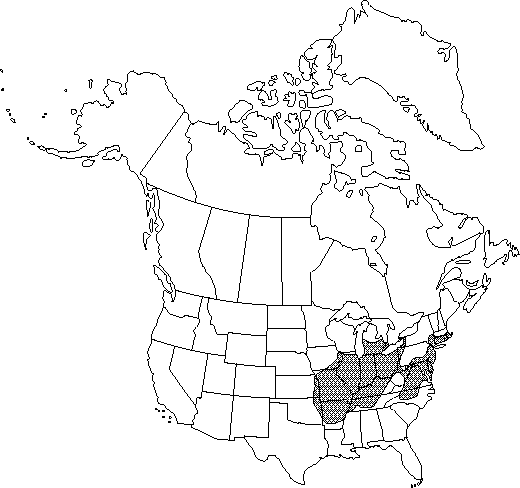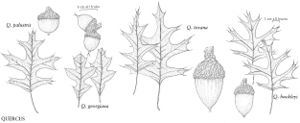Difference between revisions of "Quercus palustris"
Hausvater 5(1): 253. 1770.
FNA>Volume Importer |
imported>Volume Importer |
||
| (7 intermediate revisions by 2 users not shown) | |||
| Line 9: | Line 9: | ||
|common_names=Pin oak | |common_names=Pin oak | ||
|special_status={{Treatment/ID/Special_status | |special_status={{Treatment/ID/Special_status | ||
| + | |code=W1 | ||
| + | |label= | ||
| + | }}{{Treatment/ID/Special_status | ||
|code=E | |code=E | ||
|label=Endemic | |label=Endemic | ||
}}{{Treatment/ID/Special_status | }}{{Treatment/ID/Special_status | ||
|code=F | |code=F | ||
| − | |label= | + | |label=Illustrated |
| − | |||
| − | |||
| − | |||
}} | }} | ||
|basionyms= | |basionyms= | ||
| Line 27: | Line 27: | ||
}}<!-- | }}<!-- | ||
| − | --><span class="statement" id="st- | + | --><span class="statement" id="st-undefined" data-properties=""><b>Trees,</b> deciduous, to 25 m. <b>Bark</b> grayish brown, fissures broad, shallow, inner bark pinkish. <b>Twigs</b> reddish brown, 1.5-3(-4) mm diam., soon becoming glabrous. <b>Terminal</b> buds brown to reddish brown, ovoid, 3-5 mm, glabrous or with a few fine hairs at apex. <b>Leaves</b>: petiole 20-60 mm, glabrous. <b>Leaf</b> blade elliptic to oblong, 50-160 × 50-120 mm, base cuneate to broadly obtuse or truncate with basal pair of lobes often somewhat recurved, margins with 5-7 lobes and 10-30 awns, lobes acute or attenuate or distally expanded, apex acute to acuminate; surfaces abaxially glabrous except for conspicuous axillary tufts of tomentum, veins raised, adaxially planar, glabrous. <b>Acorns</b> biennial; cup thin, saucer-shaped, 3-6 mm high × 9.5-16 mm wide, covering 1/4 nut, outer surface glabrous or puberulent, inner surface glabrous or with a few hairs around scar, scale tips tightly appressed, acute to obtuse; nut globose or ovoid, 10-16 × 9-15 mm, often conspicuously striate, glabrous, scar diam. 5.5-9 mm. <b>2n</b> = 24.</span><!-- |
-->{{Treatment/Body | -->{{Treatment/Body | ||
| Line 34: | Line 34: | ||
|elevation=0-350 m | |elevation=0-350 m | ||
|distribution=Ont.;Ark.;Conn.;Del.;D.C.;Ill.;Ind.;Iowa;Kans.;Ky.;Md.;Mass.;Mich.;Mo.;N.J.;N.Y.;N.C.;Ohio;Okla.;Pa.;R.I.;Tenn.;Va.;W.Va.;Wis. | |distribution=Ont.;Ark.;Conn.;Del.;D.C.;Ill.;Ind.;Iowa;Kans.;Ky.;Md.;Mass.;Mich.;Mo.;N.J.;N.Y.;N.C.;Ohio;Okla.;Pa.;R.I.;Tenn.;Va.;W.Va.;Wis. | ||
| − | |discussion=<p>Quercus palustris is especially common in landscape and street plantings. Its persistent dead branchlets (pins) and branching pattern (drooping lower branches, horizontal middle branches, ascending upper branches) are quite distinctive.</p><!-- | + | |discussion=<p><i>Quercus palustris</i> is especially common in landscape and street plantings. Its persistent dead branchlets (pins) and branching pattern (drooping lower branches, horizontal middle branches, ascending upper branches) are quite distinctive.</p><!-- |
| − | --><p>This species reportedly hybridizes with Quercus coccinea (E. J. Palmer 1948) and with Q. imbricaria (= Q. ×exacta Trelease), Q. marilandica, Q. nigra, Q. phellos (= Q. ×schochiana Dieck), Q. rubra, Q. shumardii, and Q. velutina.</p><!-- | + | --><p>This species reportedly hybridizes with <i>Quercus coccinea</i> (E. J. Palmer 1948) and with <i>Q. imbricaria</i> (= Q. ×exacta Trelease), <i>Q. marilandica</i>, <i>Q. nigra</i>, <i>Q. phellos</i> (= Q. ×schochiana Dieck), <i>Q. rubra</i>, <i>Q. shumardii</i>, and <i>Q. velutina</i>.</p><!-- |
| − | --><p>Some Native American tribes used infusions prepared from the bark of Quercus palustris to alleviate intestinal pains (D. E. Moerman 1986).</p> | + | --><p>Some Native American tribes used infusions prepared from the bark of <i>Quercus palustris</i> to alleviate intestinal pains (D. E. Moerman 1986).</p> |
|tables= | |tables= | ||
|references= | |references= | ||
| Line 45: | Line 45: | ||
-->{{#Taxon: | -->{{#Taxon: | ||
name=Quercus palustris | name=Quercus palustris | ||
| − | |||
|authority=Münchhausen | |authority=Münchhausen | ||
|rank=species | |rank=species | ||
| Line 59: | Line 58: | ||
|publication title=Hausvater | |publication title=Hausvater | ||
|publication year=1770 | |publication year=1770 | ||
| − | |special status=Endemic; | + | |special status=W1;Endemic;Illustrated |
| − | |source xml=https:// | + | |source xml=https://bitbucket.org/aafc-mbb/fna-data-curation/src/2e0870ddd59836b60bcf96646a41e87ea5a5943a/coarse_grained_fna_xml/V3/V3_577.xml |
|genus=Quercus | |genus=Quercus | ||
|section=Quercus sect. Lobatae | |section=Quercus sect. Lobatae | ||
|species=Quercus palustris | |species=Quercus palustris | ||
| − | |||
| − | |||
| − | |||
| − | |||
| − | |||
| − | |||
| − | |||
| − | |||
| − | |||
| − | |||
| − | |||
| − | |||
| − | |||
| − | |||
| − | |||
| − | |||
| − | |||
| − | |||
| − | |||
| − | |||
| − | |||
| − | |||
| − | |||
| − | |||
| − | |||
| − | |||
| − | |||
| − | |||
| − | |||
| − | |||
| − | |||
| − | |||
| − | |||
| − | |||
| − | |||
| − | |||
| − | |||
| − | |||
| − | |||
| − | |||
| − | |||
| − | |||
| − | |||
| − | |||
| − | |||
| − | |||
| − | |||
}}<!-- | }}<!-- | ||
-->[[Category:Treatment]][[Category:Quercus sect. Lobatae]] | -->[[Category:Treatment]][[Category:Quercus sect. Lobatae]] | ||
Latest revision as of 21:49, 5 November 2020
Trees, deciduous, to 25 m. Bark grayish brown, fissures broad, shallow, inner bark pinkish. Twigs reddish brown, 1.5-3(-4) mm diam., soon becoming glabrous. Terminal buds brown to reddish brown, ovoid, 3-5 mm, glabrous or with a few fine hairs at apex. Leaves: petiole 20-60 mm, glabrous. Leaf blade elliptic to oblong, 50-160 × 50-120 mm, base cuneate to broadly obtuse or truncate with basal pair of lobes often somewhat recurved, margins with 5-7 lobes and 10-30 awns, lobes acute or attenuate or distally expanded, apex acute to acuminate; surfaces abaxially glabrous except for conspicuous axillary tufts of tomentum, veins raised, adaxially planar, glabrous. Acorns biennial; cup thin, saucer-shaped, 3-6 mm high × 9.5-16 mm wide, covering 1/4 nut, outer surface glabrous or puberulent, inner surface glabrous or with a few hairs around scar, scale tips tightly appressed, acute to obtuse; nut globose or ovoid, 10-16 × 9-15 mm, often conspicuously striate, glabrous, scar diam. 5.5-9 mm. 2n = 24.
Phenology: Flowering spring.
Habitat: Bottoms and poorly drained upland clay soils
Elevation: 0-350 m
Distribution

Ont., Ark., Conn., Del., D.C., Ill., Ind., Iowa, Kans., Ky., Md., Mass., Mich., Mo., N.J., N.Y., N.C., Ohio, Okla., Pa., R.I., Tenn., Va., W.Va., Wis.
Discussion
Quercus palustris is especially common in landscape and street plantings. Its persistent dead branchlets (pins) and branching pattern (drooping lower branches, horizontal middle branches, ascending upper branches) are quite distinctive.
This species reportedly hybridizes with Quercus coccinea (E. J. Palmer 1948) and with Q. imbricaria (= Q. ×exacta Trelease), Q. marilandica, Q. nigra, Q. phellos (= Q. ×schochiana Dieck), Q. rubra, Q. shumardii, and Q. velutina.
Some Native American tribes used infusions prepared from the bark of Quercus palustris to alleviate intestinal pains (D. E. Moerman 1986).
Selected References
None.
